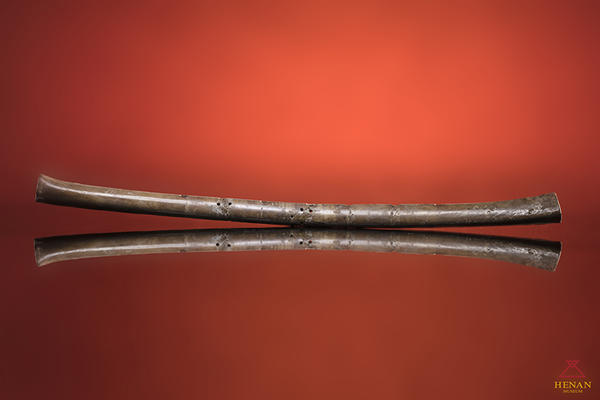
Jiahu Bone Flute
Source: Henan. gov.cn
Speech by Ma Xiaolin, director of Henan Museum
Editor's notes: For those who are staying at home during the global COVID-19 pandemic, an excellent cultural feast is needed to cheer them up! Ma Xiaolin, director of Henan Museum, has spent many years studying abroad or serving as a visiting scholar. As an attempt to promote Henan’s cultural relics “going global” and realize the internationalization of Henan Museum, he has recorded a series of videos named “Treasures of China’s Central Plains” in English for the first time to tell the stories behind the cultural relics, present international friends with exquisite artifacts and demonstrate the profound Chinese civilization to the outside world.
Episode I
The Jiahu Bone Flute
I. The flute
The bone flute was unearthed from the Jiahu Site, Wuyang County, Henan Province, in 1987, thus its name the Jiahu bone flute. This 23.6cm-long flute was made from a wing bone of the red-crowned crane 8,000 years ago, with seven finger holes. The finger holes on this wind instrument were precisely drilled by first locating the hole for the tonic note “gong” in the Chinese pentatonic scale. The tonic note “gong” is equivalent to “Do” in modern music. The other finger holes were then fixed according to the place of the "gong" hole. However, a thinner flute sounded different from a thicker one. Thus, smaller holes were drilled next to the seven larger finger holes, for sound checking. The technique was quite similar to a modern one used on traditional Chinese wind instruments.
Treasures of China's Central Plains • The Fine Details Behind丨The Jiahu Bone Flu
II. Excavation
Located in Wuyang County in central Henan and an important site from the Peiligang culture, the Jiahu Site expands over an area of over 50,000 square meters and dates back to 9,000–7,500 years ago. Eight excavation projects were launched in the site between 1983 and 2013. More than 3,000 square meters were under excavation and thousands of cultural relics unearthed, including more than 40 bone flutes.
The bone flute was in three pieces at the excavation. There were a number of joining holes, indicating that it had been carefully repaired and evidently a favorite to the owner. Yet, once restored, the three pieces made an intact bone flute that was dark brown in color and smooth in surface. The other bone flute unearthed together was well preserved.
III. How was it made
The bone flute was made from a wing bone of the red-crowned crane. The Jiahu Site was rich in fauna. Skeletons found there included those of swans, ring-necked pheasants, and red-crowned cranes. The bones of a red-crowned crane are hard and hollow. A primitive artisan may first cut off the bone heads on both ends. Then he would determine the placement of the finger holes before drilling them on the bone. Finally, tone tuning was made to this musical instrument. Cuts were found besides the finger holes, showing that repeated corrections had been made in the process. It was difficult to drill the finger holes and smaller tone-tuning holes on a hard yet fragile bone of a crane. Filing was not an easy job, either.
The microscopic examination showed spiral marks left by a running bit inside the finger holes. Hand drills and brad awls made of hard-textured materials such as crystal and flint were unearthed from the site. However, it was hard to reproduce the bone flute with similar tools and means. The Jiahu bone flute must have been a result of time-consuming experiments to find the best material and technique.
IV. Significance
More than forty bone flutes were unearthed from the Jiahu Site. They evidently followed the line of development from being simple in shape and design to getting more complicated and refined. These bone flutes fitted well the archaeological phases they belonged to. The earliest Jiahu bone flutes were supposed to be made 9,000 years ago, progressively with two, five, or six finger holes. With a millennium development or so, the bone flutes were developed into a seven-hole instrument. Later, eight-hole bone flutes emerged. The musical scale grew from a four-tone one to a five-, six-, and seven-tone. There were even sound changes.
Chinese music has a long history. It emerged in the production activities of primitive men. Primitive men of eight thousand years ago already played a "xiazhi" tune on the bone flute. It has been a piece of solid evidence to Chinese music in remote antiquity.
The Jiahu bone flute served as an important object that facilitated our understanding and study of the development of the Chinese music civilization and its early form. The discovery of the Jiahu bone flute dates China’s music history back more than 8,000 years.
The Jiahu bone flute is believed to be the earliest wind instrument ever found in the world which remains playable even this day, and it provides an important clue to the study of the world’s music history. Also, the bone flute was a piece of solid evidence to the music art and creativity of primitive men. Ancient residents of the Jiahu Site successfully developed a two-hole bone flute to a seven-hole one. They may create the first bone flute unintentionally; yet, they later made one breakthrough after another with all their efforts.
